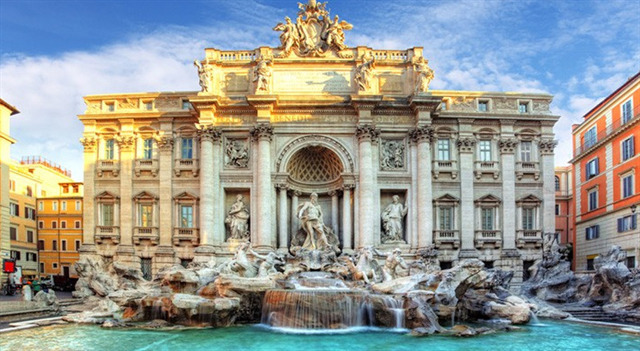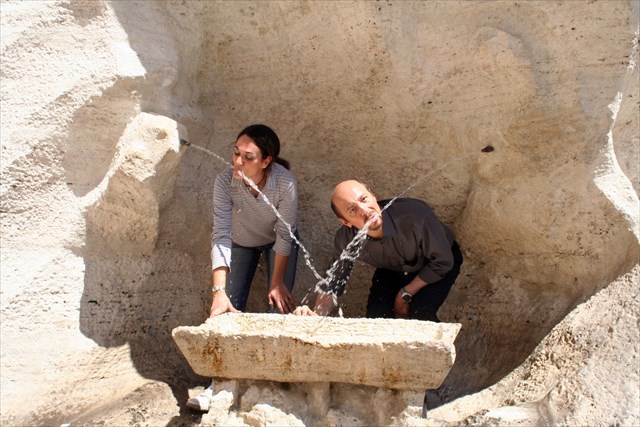FONTANA DI TREVI

La Fontana di Trevi è la più grande e una fra le più note fontane di Roma; è, inoltre, una delle più celebri fontane del mondo.
Si trova nel Rione Trevi, uno dei 22 quartieri della città di Roma. La sorgente si trova alla confluenza di tre strade, da cui il nome della Fontana (dal latino “Trivius”).
La storia di questa fonte risale ai tempi di Augusto. Secondo la leggenda, era una fanciulla misteriosa che ha indicato al generale Agrippa il luogo della sorgente, alla periferia di Roma. Per portare acqua alla città, Agrippa costruì un acquedotto (poi chiuso nel 19 a.C.), che in onore della fanciulla fu chiamato Acqua Vergine.
La fontana monumentale che oggi ammiriamo fu costruita nel XVIII secolo da Nicola Salvi, (che vinse il concorso indetto da papa Clemente XII) nel 1732 e completata nel 1762 da Giuseppe Pannini). I lavori per la sua costruzione durarono 30 anni che rovinarono le già cattive condizioni di salute di Salvi, che morì senza essere in grado di intraprendere altri progetti e senza vedere terminata la sua bella fontana. Nicola Salvi è rappresentato da Nettuno sul suo carro trainato da due cavalli che emergono dall'acqua scortato da due tritoni, che nella mitologia accompagnano sempre il Dio Nettuno; Dietro la scultura di Nettuno, una nicchia è posta sotto la facciata di Palazzo Poli.
La fontana è stata costruita interamente in travertino, e ha dimensioni di 25,9 metri di altezza per 19,8 metri di larghezza.
Il simbolo della città che rappresenta e probabilmente anche l'imponenza stessa della fontana è all'origine di leggende e aneddoti che le si infittiscono attorno e che sono entrati a far parte della cultura popolare romana.
La tradizione più conosciuta e persistente è legata al lancio della monetina dentro la fontana: compiendo questo atto a occhi chiusi, voltando le spalle verso palazzo Poli, ci si propizierebbe un futuro ritorno nella città. Si ignorano le origini della tradizione, che però potrebbe derivare dall'antica usanza di gettare nelle fonti sacre oboli o piccoli doni per propiziarsi la divinità locali, come per i pozzi dei desideri.
La tradizione è così universalmente nota che sono ben rari i turisti, anche stranieri, che si sottraggono al “rito” del lancio della monetina.
Il Comune di Roma deliberò nel 2006 che tutte le monetine recuperate (una somma pari a circa tremila e ottocento euro al giorno) dovevano essere destinate alla Caritas della capitale; ciò, tuttavia, non impedisce a qualche "dilettante" di tentare recuperi personali non autorizzati e sanzionati (quindi non provate neanche a prendere quella monetina che vi sembra molto vicina perché rischiate l’arresto…).
Sul parapetto sulla sinistra della fontana è scolpito un grande vaso di travertino (detto "Asso di Coppe" per la forma che ricorda la carta da gioco). Si dice che i costruttori l'avessero messo in quel punto per disturbare la vista di un barbiere che aveva bottega lì a fianco e continuava a criticare il lavoro dell'architetto. Effettivamente quel vaso non ha nulla a che vedere con il tema della fontana…
L’ultima curiosità sarà utilizzata come requisito necessario per
validare la vostra visita e loggare questa Virtual.
FONTANA DEGLI INNAMORATI
In pochi sanno che sul lato esterno destro della celebre fontana di Trevi si trova una vaschetta rettangolare con due piccole cannelle: la fontana degli innamorati o dei fidanzati.
Si dice che le coppie che bevono a questa fontanella resteranno innamorate e fedeli per sempre. Un rito antico che si svolgeva alla vigilia della partenza del fidanzato, specie quando la lontananza era prolungata nel tempo. La sera precedente all’addio i due giovani si recavano alla fontanella; la ragazza riempiva un bicchiere mai usato prima e lo offriva all’innamorato. Il bicchiere poi doveva essere rotto. In questo modo, la ragazza era certa di non perdere la persona amata. E il fidanzato? Avrebbe continuato a ricordare l’innamorata rimasta in città.
 Roma, quando vuole, sa essere la più romantica!
Roma, quando vuole, sa essere la più romantica! 

|
Per validare la vostra visita e loggare questa Virtual come Found it!
Si richiede di recarvi davanti alla fontanella degli innamorati e scattarvi una foto mentre bevete insieme alla vostra dolce metà. Non avete una dolce metà? Non c’è problema, scegliete chi preferite: vostra sorella, fratello, padre, madre, vostra suocera, un’amica, un cane, un gatto, un fiore, un poliziotto (forse è meglio di no…), etc…
Se poi proprio non avete nessuno, provate a rimorchiare al volo un/una turista! Nella romantica Roma, da cosa nasce cosa…
In alternativa potete fare una foto in cui si veda il vostro nome o il vostro GPS, insieme ad una monetina, appoggiati entrambi sul bordo della vaschetta degli innamorati.
Sbizzarritevi in foto spiritose e/o buffe mentre bevete alla fontanella, anche gli owners (che hanno messo la loro foto nel listing) vogliono divertirsi con voi!
AGGIORNAMENTO DEL 21/08/2019
SE LA FONTANA E' CHIUSA E NON RIUSCITE A RAGGIUNGERE LA FONTANELLA DEGLI INNAMORATI, TROVATE UNO SCORCIO DA CUI FARE UNA FOTO ALLA FONTANELLA AGGIUNGENDO IL VOSTRO NICKNAME O LA DATA DELLA VISITA. DA OGGI TUTTI I LOG CHE NON RISPETTANO LE RICHIESTE SARANNO CANCELLATI SENZA PREAVVISO.
TUTTI I LOG ANTECEDENTI I 30 GIORNI
SARANNO ATTENTAMENTE CONTROLLATI CON PROGRAMMI APPOSITI PER EVITARE FURBETTI.
|
TREVI FOUNTAIN
The Trevi Fountain is the largest and one of the most famous fountains in Rome; it is also one of the most famous fountains in the world. It is located in the Rione Trevi, one of the 22 districts of the city of Rome. The water source is located at the confluence of three streets, hence the name of the Fountain (from latin “Trivius”). The history of this water source dates back to the time of Augustus.
According to legend, it was a mysterious girl (named Trivia) who indicated General Agrippa the place of the spring, on the outskirts of Rome. To bring water to the city, Agrippa built an aqueduct (later closed in 19 BC), which in honor of the girl was called Acqua Vergine. The monumental fountain as we admire today was built in the 18th century by Nicola Salvi, (who won the competition announced by Pope Clement XII) in 1732 and completed in 1762 by Giuseppe Pannini). The works for its construction lasted 30 years which ruined Salvi's already poor health, who died without being able to undertake other projects and without seeing his beautiful fountain finished.
Nicola Salvi is represented by Neptune on his chariot pulled by two horses that emerge from the water escorted by two tritons, who in mythology always accompany the God Neptune; Behind the sculpture of Neptune, a niche is placed under the facade of Palazzo Poli.
The fountain was built entirely of travertine, and is 25.9 meters high by 19.8 meters wide.
The symbol of the city that it represents and probably also the very grandeur of the fountain is at the origin of legends and anecdotes that thicken around it and that have become part of Roman popular culture: The most well-known and persistent tradition is linked to the tossing of the coin inside the fountain: completing this act with eyes closed, turning one's back on Palazzo Poli, a future return to the city would be propitiated. The origins of the tradition are ignored, but it could derive from the ancient custom of throwing oboli or small gifts into the sacred sources to propitiate the local divinity, as for the wells of desires. Tradition is so universally known that tourists, even foreigners, who escape the "ritual" of throwing coins are very rare.
The Municipality of Rome decided in 2006 that all the coins recovered (a sum equal to about three thousand and eight hundred euros per day), had to be allocated to the Caritas an italian charity association; this, however, does not prevent some "amateur" from attempting to recover unauthorized and sanctioned personal recoveries (so don't even try to take that little coin that seems very close to you because you risk to be arrest ...).
On the parapet on the left of the fountain there is a large travertine vase (called "Asso di Coppe" for the shape reminiscent of an Italian playing card). It is said that the builders had put him at that point to disturb the sight of a barber who had a shop nearby and continued to criticize the architect's work. Indeed that vase has nothing to do with the theme of the fountain...
The last curiosity will be used as a necessary requirement to
validate your visit and log this Virtual.
THE FOUNTAIN OF LOVERS
Few people know that on the right-hand side of the famous Trevi fountain there is a rectangular basin with two small spouts: The Fountain of Lovers or Engaged Couples.
It is said that couples who drink in this fountain will remain in love and faithful forever. An ancient rite that took place on the eve of the boyfriend's departure, especially when the distance was extended over time. The evening before the farewell the two young people went to the fountain; the girl filled a glass never used before and offered it to the lover. The glass then had to be broken. In this way, the girl was sure not to lose her loved one. And the boyfriend? He would have continued to remember the lover in the city.
 Rome, when it wants, knows how to be the most romantic!
Rome, when it wants, knows how to be the most romantic! 

|
To validate your visit and log this virtual as Found it!
To validate your visit and log this virtual as Found it! it is required to go in front of the Fountain of Lovers and take a picture of yourself while drinking with your sweetheart, your sister, brother, mother, father or your mother or father-in-law, a friend, a dog, a cat, a flower, a policeman (maybe not…), etc.
If you really have no one, make a tourist fall in love with you! In the romantic Rome, you never know... Alternatively, you can take a photo of your GPS with a coin, both of which must be placed on the edge of the Fontain of Lovers sink (not the Trevi one).
Get crazy in funny things or funny pictures while drinking from the fountain, even the owners (see our photo into the listing) want to have fun with you!
UPDATE OF 08/21/2019
IF THE FOUNTAIN IS CLOSED AND YOU CANNOT REACH THE FOUNTAIN OF LOVERS, FIND A SPOT TO MAKE A PHOTO OF THIS FOUNTAIN BY ADDING YOUR NICKNAME, A COIN OR THE DATE OF YOUR VISIT TO THE PICTURE. FROM TODAY ALL THE LOGS THAT DO NOT RESPECT THE REQUESTS WILL BE CANCELED WITHOUT ANY NOTICE.
All players are advised that logs
older than 30 days, will be carefully checked with special programs to reveal tampering.
|
This Virtual Cache is part of a limited release of Virtuals created between June 4, 2019 and June 4, 2020. Only 4,000 cache owners were given the opportunity to hide a Virtual Cache. Learn more about Virtual Rewards 2.0 on the Geocaching Blog.